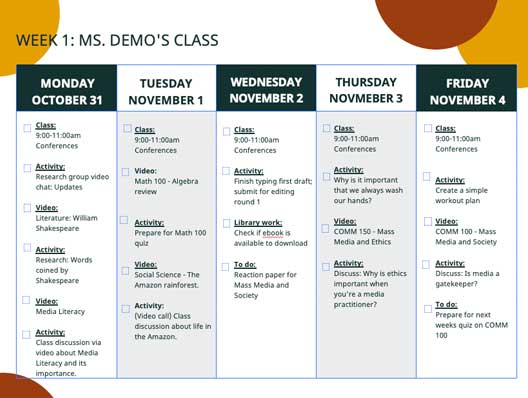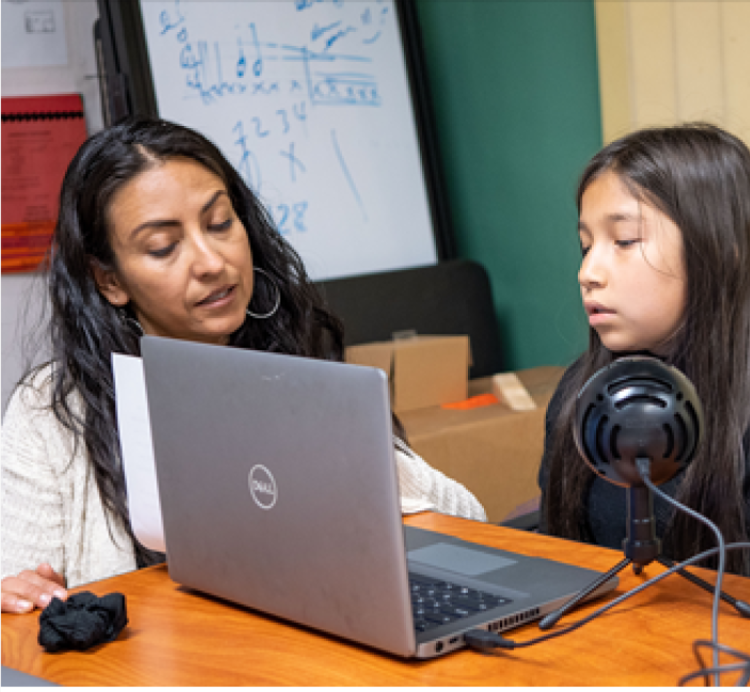Immediate Need (1-2 days notice)
If you only have a limited time to plan for a virtual transition, you will want to ensure that two essential components of virtual learning have been met including a virtual schedule that is posted with frequent reminders and an understanding of how to utilize virtual conferences in the LMS.
Setting Up Your Virtual Schedule
Create and post a daily or weekly schedule:
When students can view a visual schedule of their week or day that includes their work to be completed and/or live class times, they are more likely to engage in virtual classes and complete assignments. To create a daily or weekly schedule, follow the steps below: 
Use the pre-created schedule template or create your own using Microsoft PowerPoint, Word, or the program of your choice. Note: The template is only accessible using your BIE login.
Edit the schedule with the information for the week/day. This may include activities that have been added to the LMS, such as assignments, assessments, videos, etc. This may also include the times of classes and what tool students will use to access the virtual class meeting. Note: Use precise language when describing the assignment to complete. The title of the work should match the title of the material added in the LMS to ensure student clarity.
Save the document by selecting “Save As”, naming the file, and selecting one of the following file types from the dropdown menu: .png, or .jpg. Then select “Save”. d. Return to your course in your LMS and post the image as an Update and mark as an Announcement.
Establish Due Dates:
- Creating class materials with due dates helps manage the information flow in your classroom. Students can see when something is due, and you can see what needs to be graded using the Gradebook in the LMS.
- Due dates can be added to materials that require a student submission the following materials have the “Due Date” section available.
- Assignment
- Assessment
- Discussion
- Due dates are required to integrate with the SIS.
The objective of this plan is to facilitate the learning process of the chosen Learning Management System (LMS) for teachers and staff in a Bureau of Indian Education (BIE) school. The plan aims to provide a step-by-step approach to learning and effectively utilizing the LMS's specific features to enhance remote teaching and learning experiences. It is not specific to any LMS, but gives instructions for any LMS the school is using.
- Orientation and Familiarization:
- Attend a comprehensive orientation session led by the school's LMS administrator or designated trainer.
- Explore the LMS user interface to get familiar with the layout and navigation.
- Access the LMS dashboard to view announcements, messages, and notifications.
- Profile Setup:
- Update the user profile with accurate information, including name, contact details, and profile picture (if applicable).
- Customize notification preferences to receive timely updates from the LMS.
- Course Creation:
- Learn how to create a new course on the LMS and set up course details, such as course name, description, and course code.
- Familiarize yourself with the options to organize course content into modules or units.
- Content Management:
- Discover the various content creation tools available on the LMS, such as text-based resources, multimedia files, and links to external resources.
- Learn how to upload and organize content into the course modules or units.
- Practice embedding multimedia elements like videos, audio, and interactive content.
- Assessments and Quizzes:
- Explore the LMS's assessment and quiz features to create various types of assessments, including multiple-choice, short answer, and essay questions.
- Learn how to set time limits, grading scales, and feedback options for assessments.
- Familiarize yourself with the process of creating and managing quiz banks for random question selection.
- Assignment Management:
- Understand how to create assignments with clear instructions and submission guidelines.
- Learn how to set due dates, late submission policies, and grading criteria for assignments.
- Practice providing authentic feedback and grades on student submissions within the LMS.
- Discussion Forums and Collaboration:
- Discover the discussion forum feature to facilitate online discussions and collaboration among students.
- Learn how to create discussion topics, moderate discussions, and promote constructive dialogue.
- Communication and Messaging:
- Explore the communication tools within the LMS, such as internal messaging and announcements.
- Practice sending messages and announcements to specific individuals or entire classes.
- Gradebook and Analytics:
- Learn how to use the LMS gradebook to track and manage student performance.
- Explore the analytics and reporting features to monitor student engagement and progress.
- Synchronous and Asynchronous Learning:
- Understand how to conduct synchronous (live) virtual classes using the LMS's video conferencing or live chat capabilities.
- Learn how to facilitate asynchronous learning by providing pre-recorded lectures, resources, and activities.
- Support and Resources:
- Familiarize yourself with the LMS's support resources, such as help documentation, video tutorials, and user forums.
- Seek assistance from the school's LMS administrator or designated support personnel when encountering difficulties or questions.
- Continuous Learning and Improvement:
- Engage in regular professional development opportunities to deepen your understanding of the LMS and its evolving features.
- Share best practices and insights with colleagues to enhance the overall effectiveness of remote teaching using the LMS.
To meet with students in a virtual setting, teachers and staff can utilize the Conferences Feature (Big Blue Button) in the Schoology LMS, zoom.gov, Teams, or Google Meets.
Note: If only using audio, be mindful of your engagement strategies while cameras are off. Conversely, if using webcams, remind your students to be mindful of their environment and distractions.
This guide aims to provide step-by-step instructions on how to effectively use a conferencing tool for synchronous class sessions. Synchronous sessions allow real-time interaction between teachers and students, enabling engaging and interactive remote learning experiences. This guide is applicable to conferencing tools such as Zoom.gov, Google Meet, or Big Blue Button, but the features and interface might vary slightly. Always refer to the specific tool's documentation for the latest updates and functionalities.
Set Up and Account Creation:
- Visit the conferencing tool's website and create a teacher account using your school email address.
- Familiarize yourself with the platform's interface, settings, and available features.
Schedule a Class Session:
- Access your teacher account and schedule a new class session by selecting the "Schedule a Meeting" or "Create a Meeting" option.
- Choose the date, time, and duration for your synchronous class session.
- Copy the meeting link or invitation and share it with your students through your school's communication platform or learning management system.
Preparing for the Session:
- Set up your virtual classroom environment by choosing an appropriate background, ensuring adequate lighting, and testing your audio and video devices.
- Share any required materials, such as presentations or documents, with students beforehand, so they can access them during the session.
Joining the Class Session:
- Before the session starts, join the class using the meeting link provided or from your teacher account's dashboard.
- Greet students as they join, and ensure everyone can hear and see you clearly.
Managing Participants:
- Familiarize yourself with the participant management features of the conferencing tool, such as muting/unmuting participants, disabling video, and granting presenter privileges.
- Set ground rules for classroom behavior and guide students on using the chat and raise hand features for interaction.
Interactive Features:
- Utilize interactive features such as screen sharing to present slides, documents, or multimedia content.
- Encourage student engagement through polls, quizzes, or breakout rooms for group discussions or activities.
Effective Communication:
- Speak clearly and maintain a moderate pace to ensure students can follow the content.
- Use non-verbal cues like hand gestures and facial expressions to engage students visually.
Recording the Session (if allowed):
- If permitted and appropriate, consider recording the session for students who may not be able to attend synchronously or for future reference.
- Inform students about the recording and obtain their consent if required by school policies.
Monitoring and Interaction:
- Monitor the chat for questions, comments, or concerns raised by students during the session.
- Encourage student participation by asking questions, seeking opinions, or initiating discussions.
Time Management:
- Plan the session carefully to ensure all relevant content and activities are covered within the allocated time.
- Allocate time for student questions and feedback, ensuring a balance between teacher-led content and student engagement.
Wrapping Up the Session:
- Summarize key points discussed during the session and provide instructions or assignments for the next class.
- Remind students of upcoming deadlines or important announcements.
Post-Session Follow-up:
- Share any supplementary materials or resources discussed during the session with students.
- Send a follow-up email summarizing the main points covered and addressing any outstanding questions or concerns.
Teaching synchronous classes with remote students presents unique challenges and opportunities. This guide outlines best practices to ensure effective and engaging remote learning experiences, promoting active participation and supporting student success.
Establish Clear Expectations:
- Communicate clear guidelines for participating in synchronous sessions, including rules for online etiquette, muting microphones when not speaking, and using the chat feature respectfully.
- Set expectations for attendance, engagement, and active participation during class sessions.
Provide Accessible Materials:
- Share class materials, such as presentations and handouts, in advance through the chosen learning management system or email, so remote students can follow along seamlessly.
- Ensure materials are accessible to all students, including those with diverse learning needs.
Create an Engaging Virtual Environment:
- Use a visually appealing and clutter-free background to maintain focus during the class.
- Utilize interactive features of the conferencing tool, such as polls, quizzes, and breakout rooms, to encourage student engagement and participation.
Foster Interaction and Discussion:
- Encourage students to ask questions, share opinions, and engage in discussions using the chat feature or by unmuting themselves.
- Implement strategies to ensure balanced participation among remote and in-person students, such as rotating call-outs or using anonymous polls.
Utilize Visual Aids:
- Share your screen when presenting slides, documents, or multimedia content to support comprehension and visualization.
- Use a digital whiteboard for real-time annotations and explanations.
Maintain an Inclusive Learning Environment:
- Address remote students directly by using their names and acknowledging their contributions during the session.
- Be mindful of time zones and offer flexibility for students joining from different regions.
Encourage Collaboration:
- Use breakout rooms to facilitate small group discussions and collaborative activities.
- Assign group tasks that require remote and in-person students to work together.
Provide Timely Feedback:
- Offer feedback on assignments and assessments in a timely manner to support remote students' progress.
- Schedule virtual office hours for one-on-one interactions and support.
Record Sessions (if allowed):
- Record synchronous sessions for students who cannot attend in real-time or for review purposes.
- Ensure compliance with school policies and obtain consent from students if needed.
Be Mindful of Bandwidth and Connectivity:
- Consider using low-bandwidth options for videos and multimedia to accommodate students with limited internet connectivity.
- Be prepared with backup materials in case of connectivity issues during the session.
Seek Student Feedback
- Regularly solicit feedback from students about their remote learning experiences and adjust instructional strategies accordingly.
- Use surveys or open discussions to understand challenges and implement improvements.
Professional Development:
- Stay updated on the latest features and tools available in the conferencing platform to enhance remote teaching practices.
- Engage in professional development opportunities related to remote teaching and learning.
Use these links to access information based on user type and/or implementation speed.





